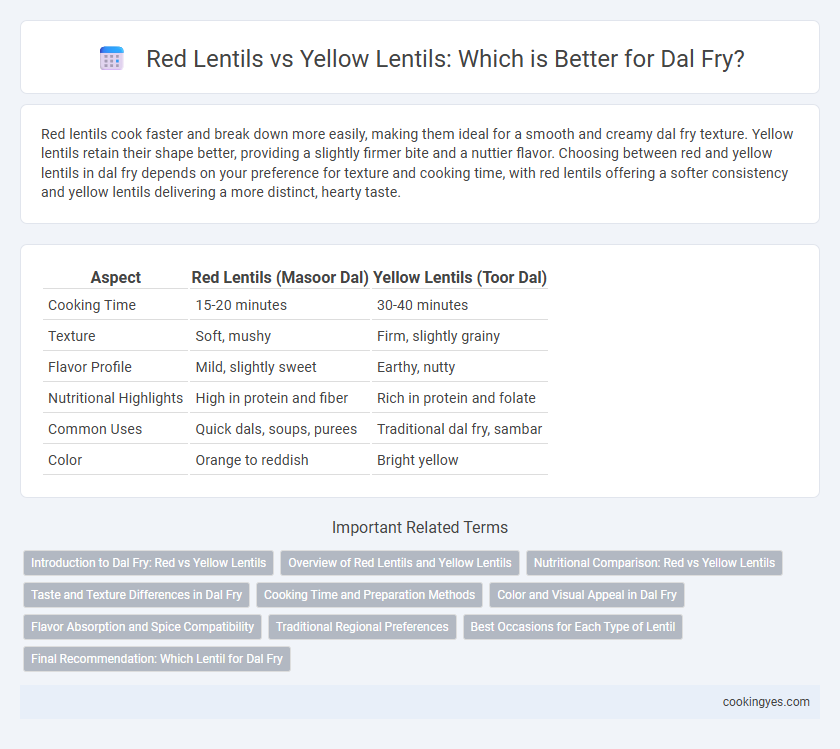Red lentils cook faster and break down more easily, making them ideal for a smooth and creamy dal fry texture. Yellow lentils retain their shape better, providing a slightly firmer bite and a nuttier flavor. Choosing between red and yellow lentils in dal fry depends on your preference for texture and cooking time, with red lentils offering a softer consistency and yellow lentils delivering a more distinct, hearty taste.
Table of Comparison
| Aspect | Red Lentils (Masoor Dal) | Yellow Lentils (Toor Dal) |
|---|---|---|
| Cooking Time | 15-20 minutes | 30-40 minutes |
| Texture | Soft, mushy | Firm, slightly grainy |
| Flavor Profile | Mild, slightly sweet | Earthy, nutty |
| Nutritional Highlights | High in protein and fiber | Rich in protein and folate |
| Common Uses | Quick dals, soups, purees | Traditional dal fry, sambar |
| Color | Orange to reddish | Bright yellow |
Introduction to Dal Fry: Red vs Yellow Lentils
Red lentils (Masoor dal) cook faster and tend to break down into a creamy texture, making them ideal for smooth and rich Dal Fry. Yellow lentils (Toor dal or Moong dal) offer a slightly firmer texture and a nuttier flavor, providing a more textured and hearty dish. Choosing between red and yellow lentils significantly influences the consistency and taste profile of Dal Fry, allowing customization to preferred culinary styles.
Overview of Red Lentils and Yellow Lentils
Red lentils (Masoor Dal) are small, round, and orange-red, known for their quick cooking time and soft texture when cooked, making them ideal for smooth and creamy dal fry dishes. Yellow lentils (Toor Dal or Moong Dal) have a mild, slightly nutty flavor with a firm texture that holds shape better after cooking, providing a chunkier consistency in dal recipes. Both lentil types are rich in protein, fiber, and essential nutrients, but red lentils absorb spices and flavors more readily, while yellow lentils offer a more robust and hearty taste.
Nutritional Comparison: Red vs Yellow Lentils
Red lentils contain higher levels of iron and folate, essential for oxygen transport and cell growth, making them a nutritious choice for dal fry. Yellow lentils provide more protein and fiber, supporting muscle repair and digestive health. Both lentil types offer a rich source of complex carbohydrates, but their slight variation in nutrient profiles can influence the flavor and health benefits of dal fry.
Taste and Texture Differences in Dal Fry
Red lentils in Dal Fry deliver a mild, slightly sweet flavor with a smooth, creamy texture that easily breaks down during cooking, enhancing the dish's richness. Yellow lentils offer a nuttier, earthier taste and maintain a firmer, slightly grainy texture, providing more bite and structure to the dal. Preference depends on desired mouthfeel: red lentils create a velvety consistency, while yellow lentils contribute to a heartier, textured experience.
Cooking Time and Preparation Methods
Red lentils cook faster than yellow lentils, typically softening in about 15-20 minutes, making them ideal for quick dal fry recipes. Yellow lentils require a longer cooking time of 30-40 minutes but offer a firmer texture and slightly earthier flavor, which holds well in slow-cooked dal preparations. Red lentils need minimal soaking and tend to break down easily, while yellow lentils often benefit from soaking to reduce cooking time and maintain shape during frying.
Color and Visual Appeal in Dal Fry
Red lentils create a vibrant, rich orange-red hue in dal fry, enhancing its visual warmth and attractiveness. Yellow lentils offer a more subtle golden color, resulting in a milder, earthy presentation that complements traditional garnishes. Both varieties contribute distinctive aesthetic qualities, influencing the dish's appeal and perceived flavor profile.
Flavor Absorption and Spice Compatibility
Red lentils absorb spices intensely due to their softer texture, making them ideal for a richly flavored dal fry with deep, aromatic profiles. Yellow lentils offer a milder taste and firmer consistency, allowing subtle spices like turmeric and cumin to shine through without overpowering the dish. Choosing red lentils enhances spice integration, while yellow lentils maintain distinct flavors for balanced dal fry variations.
Traditional Regional Preferences
Red lentils, commonly used in South Indian dal fry, cook quickly and create a smooth, creamy texture ideal for sambar and rasam. Yellow lentils, preferred in North Indian regions like Punjab and Rajasthan, provide a firmer texture and nutty flavor that hold shape well in dishes like dal tadka. Regional culinary traditions influence the choice, with red lentils favored for their softness and yellow lentils for their robust, hearty consistency in dal preparations.
Best Occasions for Each Type of Lentil
Red lentils cook quickly and are ideal for a creamy dal fry served on busy weekdays or when you need a comforting, easy-to-digest meal. Yellow lentils hold their shape better and provide a firmer texture, making them perfect for festive occasions or elaborate dinners where presentation and texture are important. Choosing red lentils suits quick, casual meals, while yellow lentils elevate special gatherings with their vibrant color and richer flavor.
Final Recommendation: Which Lentil for Dal Fry
Red lentils offer a softer texture and quicker cooking time, making them ideal for a creamy and smooth dal fry, while yellow lentils provide a nuttier flavor and firmer bite, adding more texture to the dish. For a traditional dal fry that balances taste and consistency, red lentils are preferred due to their ability to break down easily and absorb spices well. Choosing red lentils enhances the overall richness and ensures a velvety finish in dal fry recipes.
Red Lentils vs Yellow Lentils for Dal Fry Infographic

 cookingyes.com
cookingyes.com